“Bang, it’s a perfect shot! Bullseye!” I cheered, reveling in the thrill of a perfect throw as the soft-tip darts buzzed through the air. My sister Sarah, wide-eyed, was quick to exclaim, “This electronic dart board is insane!”
Flashback to the days when Sarah and I started our darting adventures at home with a traditional board. The love for the game grew, and with it, the desire for an upgrade. Finally, after months of research, trying, and testing 23 electronic dartboards, varying from $41 to $529, we settled for the TOP 7 MODELS.
While a few came with advanced voice prompts, dazzling light and sound effects, others had lots of games and stylish cabinets. Some were more budget-friendly but missed out on trendy features like online multiplayer games, while a select few excelled in every aspect, but were a wee bit on the expensive side.
But guess what? I made a list of the ABSOLUTE BEST in each category, just for you!
Ultimately, the Arachnid Cricket Pro 900 emerged as the best electronic dart board, marking a new era in our adventures. The digital scoring system was a game-changer, ending our score disputes. And those exciting games? Darting has never been so much fun before!
So, buckle up, folks! We’re on an exciting quest to find YOUR perfect electric dart machine. Let’s make it a thrilling experience for you and your family.
Top Picks For Electronic Dartboard (Quick List)
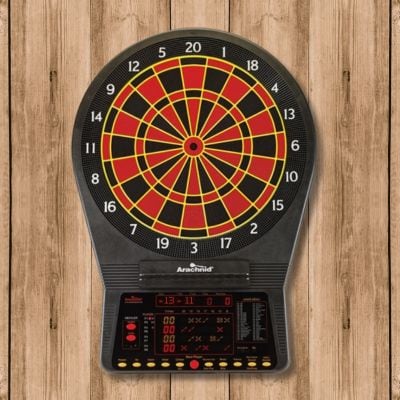
1. Arachnid Cricket Pro 900 Electronic Dart Board (The Overall Best)
Key Features: 15.5″ target area, 48 games (including 301, Cricket) with 354 scoring options for 8 players, advanced voice prompts.
Read More: Arachnid Cricket Pro
4.7/5
Our Rating
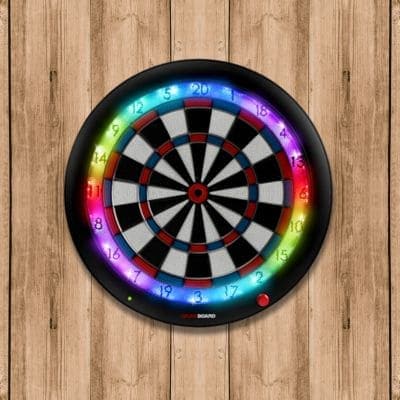
2. Granboard 3s Smart Digital Dartboard (Next-Generation Tech)
Key Features: 15.5″ target area with illuminated outer ring, 25+ games including 01, Cricket, & online games, battery-operated.
Read More: Granboard Electronic Board
4.7/5
Our Rating
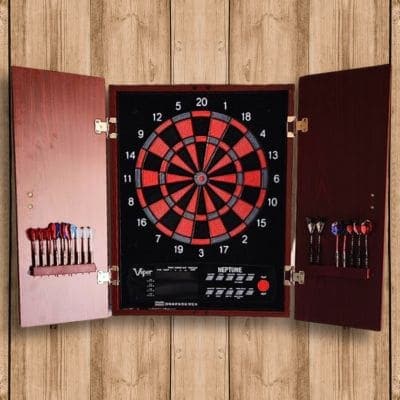
3. Viper Neptune Electronic Dart Board (Best Cabinet Design)
Key Features: 15.5″ target area, 57 games, 300 scoring options for 16 players, wooden finish, 16 slots for soft-tip darts inside the cabinet.
Read More: Viper Neptune
4.6/5
Our Rating
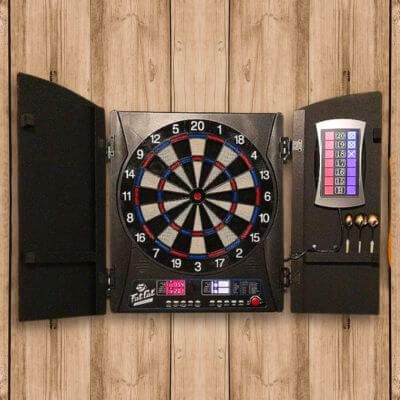
4. Fat Cat Mercury Electronic Dart Board Set (Best 13.5″ Board with Cabinet)
Key Features: 13.5″ target area, 28 games with 150 scoring options for 8 players, 6 spare soft tips, and dual storage for 6 darts.
Read More: Fat Cat Mercury
4.5/5
Our Rating
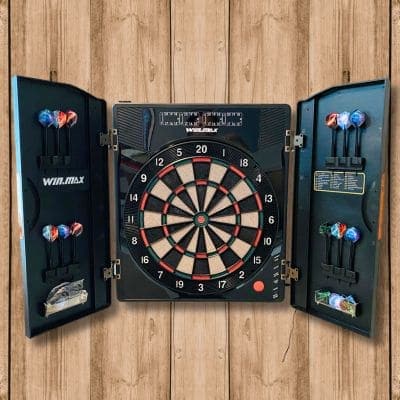
5. Win Max Soft-Tip Dart Board Set With Cabinet (Most Compact in $150)
Key Features: 13.5″ target area, 27 games with 259 scoring options, scoreboard for 8 players, concave segment holes, and sound volume 0-7.
Read More: Win Max Dartboard
4.4/5
Our Rating
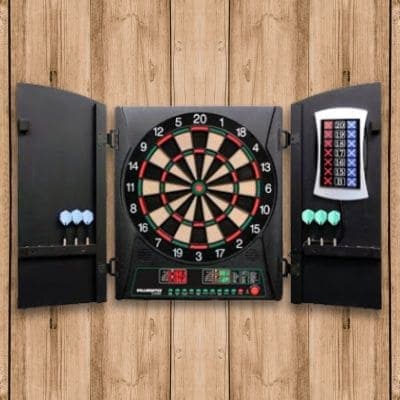
6. Bullshooter Electronic Dartboard (High-quality under $200)
Key Features: 13.5″ target area, 34 games with 183 scoring options, scoreboard for 8 players, 2 sets of soft-tip darts, and 4 score displays.
Read More: Bullshooter Dartboard
4.4/5
Our Rating
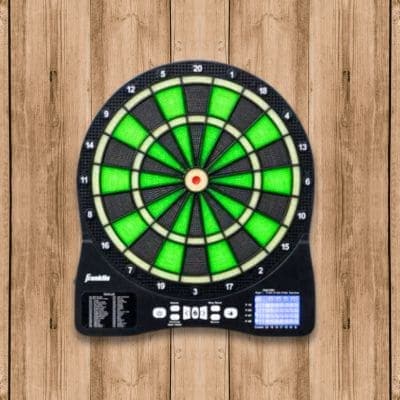
7. Franklin Sports Electronic Dart Board (Unique Functions Under $100)
Key Features: Bright LED lighting on the 13″ target area, 48 game modes, 315 scoring options, 8-player compatibility, and 3 AAA batteries needed.
Read More: Franklin Sports Dartboard
4.3/5
Our Rating
The Best Electronic Dart Boards Of 2024: Full Details
1. Arachnid Cricket Pro 900 Dartboard
Best Overall Electronic Dart board

Specifications
Target Area: 15.5″
Dimension: 21″ x 29″
Weight: 11.73 lb
Number of Games: 48
Scoring options: 354
Maximum Players: 8
Material: Nylontough, Ppd
Our Review Score: 4.7/5
What Makes Arachnid Cricket Pro 900 Electronic Dart Board Outstanding?
Meet the Cricket Pro 900 dart board from Arachnid – it’s my absolute favorite! Why? Well, first off, it talks! The voice prompts take the excitement to a whole new level. Your scores not only show up on the display but get announced by the device itself. Imagine the fun of that!
But here’s the real kicker – the 3-level Heckle feature. Activate it, and the digital board starts to taunt you for bad throws or offer words of encouragement for good ones, adding a more interactive feel to it. I couldn’t stop myself from bursting out laughing when it asked Sarah to open her eyes after she landed two fives- HAHAHA!
Now, beyond the family fun, the Cricket Pro 900 is serious about games. It offers a whopping 48 dart games to choose from (along with 8 new games). And for 301 (cricket) enthusiasts, there’s a one-touch quick-select option- a breeze to use and have fun!
In my time with this electronic Cricket dartboard, I’ve found the backlit LCD screen to be a real visual treat. It not only takes care of scoring automatically but also shows your Point Per Dart (PPD) and Marks Per Round (MPR) – crucial stats for different games.
Some years back, I first played on this wall-mounted dart machine at a nearby bar and was immediately drawn to it. While it’s an excellent choice for game rooms, its appeal extends to commercial spaces like clubs and bars, keeping people engaged and entertained.
So, whether you’re hosting a dart party with up to 8 friends or just enjoying a solo game, it has you covered. Plus, the dart averaging feature in 01 games lets you evaluate your performance at the end of each round. HOW COOL IS THAT?
In my opinion, this Arachnid Cricket Pro 900 deserves the crown for the best home electronic dart board I have ever experienced. Playing on this Cricket dartboard with Sarah and my friends is always an absolute blast- PERFECT for kids, teens, and adults alike. It feels really great when the soft-tip darts hit the target and do not bounce off.
I have been using this product for more than 3 years now and found it pretty durable. In fact, I am so satisfied with it that I won’t need another one anytime soon. When it comes to all the cool benefits at a price under $400, it’s definitely earned its spot as my ALL-TIME FAVORITE.
4.7/5
OVERALL SCORE
Arachnid Cricket Pro 900
Appearance: 4.6/5
Performance: 4.7/5
Quality: 4.8/5
Ease Of Use: 4.8/5
Value For Money: 4.7/5
PROS
This dartboard boasts a very strong build quality with durable NylonTough segments.
Unboxing the product, I discovered that it comes with a pack of 45 extra dart tips.
Darting has become a lot more fun than usual with the voice prompts, light, and sound effects.
With 48 dart games to choose from, it never gets boring.
Bounce-outs are surprisingly rare compared to other soft-tip dart boards, thanks to the thin segment dividers.
CONS
With a price tag of over $300, it is a little expensive. However, the value for money is unmatchable.
For those looking for budget-friendly options, the other model Cricket Pro 800 is a great option too with 39 games and 179 variations. If you’re on a tighter budget and aiming for the best under $200, the Cricket Maxx 4.0 is worth a look. Its compact design and wooden door cabinet caught my attention.
But wait, there’s more! Knowing how useful a dartboard cabinet can be, I’d also recommend the Arachnid Titanium 5400 as a great alternative. If you don’t have a dedicated game room with suitable storage space for your dart supplies, it will be a perfect choice.
So, whether you’re a pro or just a beginner, no worries, there’s an Arachnid dart board waiting for you!
2. Granboard 3s Smart Digital Dart Board
Next-generation Tech For Home

Specifications
Target Area: 15.5″
Dimension: 22.5″ x 22.5″
Weight: 6.2 lb
Number of Games: 25+
Special Feature: Connectivity to Android and Google devices to play with players around the world
Material: Plastic and wood
Our Review Score: 4.7/5
What Factors Contribute To The Excellence Of This Electronic Dartboard?
Are you ready to elevate your dart-playing experience to new heights? Look no further than this gem in the $300 range – a sleek and minimalistic SMART electronic dart board that seamlessly integrates cutting-edge technology with classic gameplay like no other!
Designed with modern enthusiasts in mind, it boasts Bluetooth 4.0 connectivity specifically tailored for Android, iOS, and Google devices (phones, tabs, etc.). The convenience of connectivity opens up a world of possibilities, allowing you to sync it effortlessly with your smartphone. But that’s just the beginning of the magic this digital dart board has to offer.
The real game-changer? An intuitive app that transforms your smartphone into a control center for an unparalleled dart-playing adventure. Dive into a variety of game modes, set up your personalized player profile, and engage in thrilling matches with opponents from across the globe.
Yes, you heard it right – this smart electronic board is more than just cool with LED; it’s a revolution in dartboard technology. When I installed the app on my iPhone and set up my profile, I discovered a treasure trove of more than 25 games-
- 01 Games: 301, 501, 701, 901, 1101 and 1501.
- Cricket: Standard, Hidden, Cut Throat, and Cut Throat Hidden.
- Medley: 3LEG, 5LEG, 7LEG.
- Animal Battle (against the computer): Level 1-9.
- Practice: 15 games for solo play.
- Party: 6 games for various events.
- Online Play: This is where I find it most amazing. Unlike any other dart boards I used earlier, I can engage with numerous players all over the world right at my home.
The next time you feel like playing darts with a friend, you don’t even have to ask them to come over to your residence. With a Greenbard board at their place, you can easily connect and play with them online. Just like multiplayer video games, you can use the app to add people to a friend list and chat with them.
How FASCINATING is that?!
What’s more, you don’t even need to have friends to be able to play darts. The app allows you to find other online players, both domestic and global. I found it to be pretty intuitive and user-friendly – perfect for kids and newbies. In fact, I’ve recently gifted this sleek board to my nephew in New York so that we can enjoy darts remotely from Jackson, my city.
That’s not all! Its battery-powered operation is another great feature, but hey, don’t worry, they don’t run out fast. Unlike most digital dart boards, you don’t necessarily have to mount it somewhere near a power source. This, along with its lightweight design, makes it highly portable.
So, if you are looking for the best battery-operated electronic dart board with the next-generation tech for your home, look no further! Enjoy a totally unique darting experience. The Bluetooth-connected app not only makes things much easier, but the additional features make it totally worth the money.
After all, how many electronic dart machines allow you to play with real players online?
4.7/5
OVERALL SCORE
Granboard 3s Smart Electronic Dartboard
Appearance: 4.7/5
Performance: 4.6/5
Quality: 4.8/5
Ease Of Use: 4.6/5
Value For Money: 4.7/5
PROS
The app-based smartphone connectivity was definitely a pleasant surprise.
Cool LED around the ring makes it very attractive.
You can play with players from around the world at any time.
The exclusive darts game modes really add to the fun.
You can be more flexible with the placement since the board is battery-operated.
The smartphone app is way easier to use than the integrated controls in other dartboards.
CONS
It is also slightly expensive, but the offerings are unmatched.
3. Viper Neptune Electronic Dart Board
Best 15.5″ Dart Board With Cabinet

Specifications
Target Area: 15.5″
Dimension: 21.5″ x 26.5″
Weight: 20.3 lb
Number of Games: 57
Scoring options: 300
No. of Players: 16
Material: Nylon
Our Review Score: 4.6/5
What Makes Viper Neptune Electronic Dart Board A Great Pick?
Hey Darts Lovers, let’s talk about the Viper Neptune – the ultimate electronic dart board for beginners (like my sister), with a large catch ring for off-target darts. This not only saves us the hassle of picking darts off the ground but also means that the dart tips are less prone to damage due to hitting the wall or the floor.
But wait, there’s more! This bad boy doesn’t just sit there; it comes in a sleek wooden cabinet, giving my game room a touch of class and keeping my darts organized and protected from dust. If that’s not amazing, I don’t know what is!
I love the large display, which is well-suited for specialty games like Spanish Cricket and Minnesota. The appearance of this wall-mounted electronic dartboard cabinet is so cool and minimalistic that turned my room into a sight to see!
Similar to the Arachnid 900, the Viper Neptune boasts a 15.5″ target area– though it’s a tad wider by half an inch, it stands 2.5″ shorter. But no need to fret; it doesn’t affect the gaming vibe.
Installing the board was a breeze too. I just had to drill two holes in the wall, pop in the anchors, fit 1/8″ screws, and hang it on the keyhole slots around the middle area. EASY PEASY!
The real fun began after turning on the digital dart board. Planning a house party? It’s the perfect choice, accommodating up to 16 players with a whopping 57 games and over 300 scoring options. Boredom? Absolutely not. We spent 3 hours straight exploring different games and playing together!
Now, after months of use, let’s talk durability – the Viper Neptune is no fragile thing- it’s still one of the best-rated electronic dart boards on the market in 2024. Its nylon body is highly durable- tough, with no electric malfunction, and (mine) has lasted through all the game nights for years.
QUICK ADVICE: Never throw steel-tip darts on the target. Stick to 3/4″ soft-tip darts with tips made of plastic or rubber for a great experience.
Overall, I am very satisfied with this dart board; if my previous picks were a bit expensive to you, I highly recommend going for this one. I’m confident you won’t regret it!
4.6/5
OVERALL SCORE
Viper Neptune Electronic Dart Board
Appearance: 4.7/5
Performance: 4.5/5
Quality: 4.6/5
Ease Of Use: 4.7/5
Value For Money: 4.6/5
PROS
The diverse variety of games and game settings keep things from getting repetitive and boring.
I love the build quality of this dart board – it’s bound to last a long time.
The large catch area is really helpful and beginner-friendly.
With its sleek and elegant aesthetics, it would fit well pretty much anywhere in the home.
If you don’t have a dart cabinet already, getting a board that comes with one is always a good idea.
CONS
Although I didn’t find the electronic display as aesthetically pleasing as the previous pick, it shows all the essentials.
Looking to skip the whole cabinet deal from the same brand? The Viper Ion electronic dartboard is a solid option. Another standout pick for me is the Viper 850, which caught my eye with its spacious and beautiful displays.
While these products lean a bit towards the pricey side, fear not, as the brand has some economic dartboards in its lineup. Meet the Viper Showdown, coming in around $50 – it’s one of the most budget-friendly machines without sacrificing the playing experience.
So, fellow dart enthusiasts, whether you’re looking for advanced features or keeping it budget-friendly, Viper has a dartboard that matches your groove. Let the games begin!
4. Fat Cat Mercury Home Electronic Dart Machine
Best 13.5″ Electronic Dartboard With Cabinet

Specifications
Target Area: 13.5″
Dimension: 26″ x 22″
Weight: 10.85 lb
Number of Games: 28
Scoring options: 150
No. of Players: 8
Material: ABS
Our Review Score: 4.5/5
Why Is Fat Cat Mercury An Awesome Choice For Electronic Dartboards?
Let’s talk about the Fat Cat Mercury – an electronic dart board that’s turning heads with its sleek black finish and built-in cabinet doors. While it might not boast the same classic wood cabinet style as the Viper Neptune, it brings a modern touch that’s perfect for a contemporary game room. And hey, NO COMPLAINTS about its top-notch build quality.
I’d recommend the Fat Cat Mercury for players with some dart-throwing experience. It’s slightly smaller than the standard 15.5-inch electric boards, with a 13.5-inch diameter. This compact design adds an extra layer of challenge, making it my preferred pick when gearing up for a competitive event.
While it is cool for experienced players, beginners might find it a bit challenging if they’re still getting the hang of hitting the target. That said, the sleek and space-saving size makes it the best soft-tip dart board for those who want a kid-friendly lightweight cabinet setup in their homes.
What caught my eye was the MINIMAL BOUNCE-OUTS. Taking a closer look, I found that the segment holes are designed to be concave and a thin spider, keeping those darts right where they belong. And the six spare tips that come with the set are a nice bonus – you can never have too many dart tips when playing with soft-tip darts.
In a nutshell, if you’re after a good electronic dartboard cabinet set in the range of $100, this 13.5-incher is a solid bet. It may offer fewer game modes compared to the previous two models, but you still get a decent selection of 28 different dart games.
4.5/5
OVERALL SCORE
Fat Cat Mercury Electronic Dart Board
Appearance: 4.5/5
Performance: 4.3/5
Quality: 4.4/5
Ease Of Use: 4.5/5
Value For Money: 4.6/5
PROS
If you don’t have much space, the compact design would definitely help.
The added level of difficulty helps improve your dart skills a lot.
Fat Cat Mercury isn’t as noisy to play on as most electronic dart machines.
Playing darts is much more fun when you don’t have to deal with frequent bounce-outs.
The sleek cabinet doors give the set a nice modern aesthetic appeal.
CONS
It offers a limited number of games compared to the other models that made it to this list.
If you’re looking for a broader range of game options, the Fat Cat Electronx is worth considering. It offers an expanded selection to keep your darts games diverse and engaging.
On the budget-friendly side, the Fat Cat 727 is a solid option, priced at less than $50. It provides a cost-effective choice without compromising on the essential features, making it an excellent pick for those mindful of their spending.
5. Win Max Wall-Mounted Soft-Tip Dart Board Set
Most Compact Cabinet Around $150

Specifications
Target Area: 13.5″
Dimension: 19.69″ x 19.69″
Weight: 11.44 lb
Number of Games: 27
Scoring options: 259
No. of Players: 8
Material: ABS
Our Review Score: 4.4/5
What Unique Qualities Does The Win Max Electronic Dart Board Possess?
Hey darts fans, check this out! A few months back, I was on the hunt for a cool electronic dartboard cabinet to gift my friend, and guess what I found? This awesome machine doesn’t cost a ton but is packed with exciting gaming facilities for multiple players.
Okay, let’s break it down. You get 27 games, a whopping 259 scoring options, and it can host a darts party for up to 8 players! And get this – if you’re playing solo, you can dial up the challenge with five different difficulty levels. Talk about VERSATILITY!
Now, let’s talk about what’s inside the box. You’ve got 12 well-crafted soft-tip darts, each with a solid grip for a comfortable throw, along with the board itself. When I tested, the full grip texture allowed me to be more versatile with the finger placement rather than having to choose between front and rear-loaded grips.
The barrels of the darts are nicely done, adding a touch of quality to your game. And those Polypro flights? They’re not just about looks – they play a key role in keeping your darts on a steady and smooth flight path. Simple as that!
Let’s dive into the nitty-gritty – the catch ring of the Win Max dart board. Although the target area of 13.5″ is slightly less than the Arachnid Cricket Pro 900 and Viper Neptune, it is decent for most players. The concave holes and ultra-thin spider do a great job securing the darts and MINIMIZING BOUNCE-OUTS.
And the cabinet? It’s not just storage; it’s a fortress for your darts. I love its appearance and build quality – the sturdy ABS doors came with enough slots to store four dart sets and other accessories. Practical and stylish, my friend.
In a nutshell, this is one of the best electronic dartboards for beginners. You get a bang for your buck, a well-designed cabinet to store everything in a compact space, top-notch build quality, interesting games, and the ergonomics of the darts –all add up to deliver a great experience. It’s a win-win-win kind of deal!
4.4/5
OVERALL SCORE
Win Max Soft-Tip Dart Board Set
Appearance: 4.2/5
Performance: 4.3/5
Quality: 4.4/5
Ease Of Use: 4.5/5
Value For Money: 4.4/5
PROS
The ergonomic design of the darts makes them really easy and comfortable to grip and throw.
Priced at less than $200, this is one of the most economical wall-mounted dartboards with cabinets.
I’ve experienced only a few bounce-outs while playing on this device.
You can easily store up to four sets of darts and other darts accessories in the cabinet door slots.
The sound quality in this soft-tip dart board is really crisp and clear.
CONS
Less number of games than the previous products.
Personally, I don’t like the placement of the scoreboard on the top, but the choice may vary for different users.
6. Bullshooter Electronic Dart Board Cabinet Set
High-quality Board Under $200

Specifications
Target Area: 13.5″
Dimension: 39.2″ x 23.9″
Weight: 10.7 lb
Number of Games: 34
Scoring Options: 183
No. of Players: 8
Material: Wooden doors
Our Review Score: 4.4/5
Why Should You Consider The Bullshooter Electronic Dart Board?
If you liked the Arachnid Pro and its heckler feature but want something new, check out this one—it’s perfect for you. Bullshooter, part of the ARACHNID brand, might not be as familiar, but it’s one of the best dart boards for quality and aesthetics. Its walnut-finish wooden cabinet added a touch of class to my gaming room.
Round up your crew because this dartboard lets up to eight players dive into 34 different darts games. The cherry on top? A sleek X/O Cricket scoreboard screen that’s seamlessly part of the cool appearance.
And yes, you guessed it right—the electronic dart board cabinet keeps the party alive with its heckler feature. Get ready for some hilarious comments based on your throws!
Inside the box, you’ll find two sets of darts—three black and three red. With a target area diameter of 13.5 inches, it’s the sweet spot for those who crave a challenge. Just a tiny gripe: I wish the sound effects and heckler prompts could be a bit louder. While fine for home use, they might get lost in the noise of a crowded bar.
But wait, there’s more! This Bullshooter digital dart machine is a more ECONOMICAL option compared to the Cricket Pro 900, offering a decent variety of games and cool features. Playing with my sister in heckle mode is always a riot!
Overall, if you want to impress your friends without spending too much, this board is a clear winner.
4.4/5
OVERALL SCORE
Bullshooter Electronic Dart Board
Appearance: 4.4/5
Performance: 4.3/5
Quality: 4.5/5
Ease Of Use: 4.4/5
Value For Money: 4.5/5
PROS
Once again, the heckler feature is pretty fun to have.
The compact target area adds to the challenge.
Coming from Arachnid, Bullshooter is a brand I can trust in terms of quality and reliability.
The walnut finish cabinet doors give the dartboard set a sleek and elegant look.
CONS
The sound effects could have been a bit louder.
7. Franklin Sports Light Up Electric Dart Board
Unique Design And Functions Under $100

Specifications
Target Area: 13″
Dimension: 15.63″ x 17.5″
Weight: 4.2 lb
Number of Games: 48
Scoring Options: 315
No. of Players: 8
Material: Plastic
Our Review Score: 4.3/5
What Sets The Franklin Sports Electronic Dart Board Apart From Others?
Hey, check out this awesome dartboard from Franklin Sports that I just came across! It’s not your typical board – it’s the best digital dart board with a cool light-up target area made with LEDs that give it a real arcade-style vibe. You can even play in the dark for that EXTRA THRILL.
But here’s the kicker – it’s not just flashy; it comes with a bunch of super fun games that make use of the lights – a whopping 48 games! Trust me, it’s a game-changer, and you won’t get bored. I vividly recall the first time I tried it the first time with my buddy Jeremy – we were hooked for a solid 2 hours straight!
And here’s its beauty – you only need 3 AAA batteries to power it up. So, you can take this thing anywhere without stressing about finding an outlet. It’s compact, and very lightweight with a 13-inch target area, making it highly portable.
Planning a hangout with FRIENDS or FAMILY? This wall-mounted dart board is your go-to for some guaranteed good times. Plus, mounting it on walls or doors is a piece of cake.
Sure, it doesn’t come with a cabinet, but it’s got these handy built-in slots for your darts. The backlit scoreboard is a standout – it shows scores for 4 players at once, and up to 8 players (even kids!) can jump in on the action. And for a compact, budget-friendly soft-tip digital dart machine, this one hits the bullseye!
No doubt, if you’re looking for a HOME ARCADE experience, this sleek Franklin Sports electronic dartboard is where it’s at. The light-up target area and exclusive game modes take the fun to a whole new level. Ideal for a cozy game room with limited space – you can stick it anywhere you fancy!
4.3/5
OVERALL SCORE
Franklin Sports Electronic Dart Board
Appearance: 4.5/5
Performance: 4.2/5
Quality: 4.4/5
Ease Of Use: 4.3/5
Value For Money: 4.3/5
PROS
No doubt, the light-up feature kicks the fun up a notch at house parties, especially with those one-of-a-kind game modes.
The compact and lightweight design makes this dartboard highly portable.
I found the integrated dart slots to be quite a practical alternative to cabinet storage.
Mounted on the wall, this board is a versatile choice – just pop in some batteries, and you’re good to go anywhere.
The buttons are pretty sturdy and easy to press.
CONS
With no cabinet doors to protect the dart board, it lies open to dust and would have to be cleaned more frequently.
What Makes A Digital Dart Board Better Than Others?
As someone who has spent a lot of time playing darts, I became increasingly curious about the differences between electronic dartboards and regular ones.
I later purchased the Arachnid Cricket Pro 900, Viper Neptune, and Fat Cat Mercury electronic dart boards, and played for months. Eventually, everything became clear to me. So, let me break down the main differences between electronic and regular boards based on what I’ve learned.
| Point Of Difference | Traditional Dartboards | Electronic Dartboards |
|---|---|---|
| Board Material | Wood, bristle (sisal or hemp), cork, or coiled paper | Plastic or resin |
| Dart Type | Steel-tipped | Soft-tipped (Plastic or rubber) |
| Scoring | Manual | Automated |
| Dart Weight | 25 to 50 grams | 16 to 20 grams |
| Durability | Very high to very poor, depending on the material | Fairly durable |
| Beginner-Friendliness | Might be difficult for beginners | Great for starters |
| Ideal For | Professionals | Casual players, starters, and hobbyists |
| Minimum Age | 10 years and older | 6 years and older |
| Safety | More risky due to the sharp steel dart tips | Very safe to play, even for kids |
| Special Features | None | Player ranking, handicapping, different game modes, light and sound effects, etc. |
| Price Range | $8 to $500 (Depending on the type) | $40 to $5000 |
If you’re a newbie to darting, you might be pondering whether electronic dart boards are a BETTER CHOICE than traditional ones. I get it – I was in the same boat until I took the plunge and got my first electronic dart board.
So, the million-dollar question – should you invest in an electronic dartboard? These high-tech boards certainly offer a plethora of advantages, but it’s equally crucial to be aware of their limitations. Here’s what I’ve gleaned from my extensive experience with them:
The Advantages
1. Exceptional Safety
The paramount benefit of electronic darts lies in their inherent safety. With soft tips on the darts, beginners can delve into the fun without hesitation. The risk of accidental injuries, a looming concern with steel-tipped darts, is practically eradicated.
2. Immersive Sound and Light Effects
While electronic dartboards may not mimic the experience of bristle boards, they compensate with a captivating array of sound and light effects. Hitting different sections of the board triggers various sounds, adding an element of entertainment.
My nephews, for instance, have grown even more enamored with darts since our Arachnid electronic dartboard arrived. Features like heckle mode and other sound and light effects add excitement to the experience. After spending so much time with different types of dartboards, soft-tip boards are more glamorous.
3. Diverse Game Modes
Electronic dart boards support a wide array of dart games like 301, 501, or Cricket, injecting fun and variety into your playing experience. You can easily configure the scoring system to your liking, with special effects adapting to each game’s unique demands.
4. Most User-Friendly
LET’S ADMIT IT: these sophisticated digital darting boards are remarkably easy to use, particularly when compared to traditional boards. Learning the ropes of an electronic dartboard is a breeze, and the automatic scoring system adds an undeniable layer of convenience.
These boards serve as an ideal gateway for beginners, especially children, to delve into the world of darts without feeling overwhelmed.
5. Automated Scoring
Forget about pen and paper – with a digital dartboard, tracking scores becomes a breeze. The top-notch boards feature large displays that not only show everyone’s scores but also provide extra info like average points per shot.
6. More Advanced Features
Electronic dart boards introduce a slew of additional features simply unattainable with bristle or wooden boards. For instance, you can implement handicaps to level the playing field when competing against a child or a novice.
Moreover, these boards are equipped to record and rank players based on their scores, adding an exciting competitive edge to your games.
The Limitations
1. Maintenance Demands
Soft-tip boards require a bit more care due to their sensitivity to damage, particularly concerning the sensors and other electronic components. Exposure to moisture or extreme temperatures should be avoided at all costs.
2. Higher Price Tag
Electronic dart boards usually cost a bit higher compared to traditional ones. This discrepancy is hardly surprising, given the special features they offer. Personally, I believe their price is justified by the enhanced experience they provide.
3. Chances Of Bounce-Outs
The operational mechanism of an electronic dart board makes it slightly more susceptible to bounce-outs. In traditional boards, darts typically pierce the surface and adhere as long as they’re thrown with adequate force.
However, in a digital board, darts are designed to enter the tiny holes rather than piercing the material. If a dart strikes the space between two holes, it may not secure a grip and could bounce off.
Overall, the decision to acquire an electronic dartboard hinges on your preferences, playing style, and specific requirements. Electronic dart boards offer an unbeatable blend of safety, entertainment, and accessibility, making them an enticing choice for casual players and enthusiasts alike.

How To Choose The Best Value Electronic Dart Board Set For Your Game Room?
Alright, you’re set on getting an electronic dart board, but which one is the right fit for you? Here’s my approach – I create a checklist of the following criteria and use it to narrow down my options.
- Board size
- Design of the dart board
- Ease of installation
- Pre-loaded games
- Display features
- Power requirements
- Lighting, sound effects, and voice prompts
- Beginner vs advanced player features
- Compatible darts
- Popular brands
- Easy cleaning and maintenance
- Price range
Board Size
Selecting the right dartboard size is crucial in finding the perfect pick for your preferences. Although the standard target area is approximately 15.5 inches in diameter, variations exist, and additional considerations come into play.
Take, for example, the Franklin Sports dart board, celebrated for its compact design featuring a 13-inch target area and a modest catch space. On the flip side, the Viper Neptune demands more room, boasting expansive catch areas and two wide-open cabinet doors during play.
Here are key considerations to ponder when determining the ideal size of the board:
- Player Skill Level and Catch Area: Are you a professional seeking precision, or just starting out? Who is this dart board for: kids, adults, or both? Do you prefer a larger catch area or a smaller one? Tailor your choice to your skill level.
- Available Space Assessment: Evaluate the space you can allocate for the dartboard, factoring in any additional components such as catch areas or cabinet doors.
- Challenge Preference: Define your preference for the challenge – beginners may benefit from a larger catch area to minimize wall hits, while professionals might lean towards a compact target area for an intensified level of play.
Design Of Electronic Dart Boards
By dartboard design, I’m referring to both aesthetic appeal and practical features that affect its appearance. Of course, you’d want to get a home electronic dartboard that matches the vibes of your game room.
For instance, while a classy setting calls for an elegant dartboard like Viper Neptune, the Granboard 3s, and Franklin Sports dartboards are much better for a casual and arcade-like atmosphere.
Here are specific design elements to scrutinize:
- Cabinet: If space permits, I recommend investing in a wall-mounted dart board cabinet set for your home. A cabinet serves a dual purpose by shielding your toy from dust and damage while providing convenient storage for all your dart supplies.
- Segment Dividers: Pay attention to segment dividers or the spider – excessively thick dividers can result in frustrating bounce-outs. The Arachnid Cricket Pro 900 sets a standard with its ideal thickness, minimizing bounce-outs.
- Dart Holes: During my evaluation of various digital dartboards, I discovered that some feature special holes designed to prevent bounce-outs by securely holding the darts in place. Opting for such a product ensures a smoother and hassle-free playing experience.
Lastly, don’t overlook additional design features, such as storage slots, which can prove to be exceptionally useful. These elements collectively contribute to both the visual appeal and functionality of your electronic dartboard.
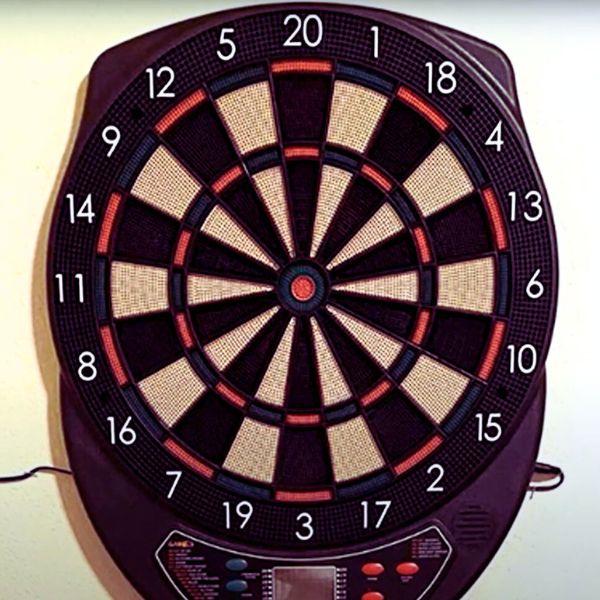
Ease Of Installation
When it comes to ease of installation, most electronic dart machines are generally USER-FRIENDLY. As you might guess, you have to drill the wall, put screws and hang the key slots present on the back. However, it’s still a crucial aspect to consider when on the lookout for an electronic cricket dartboard.
Notably, the Franklin Sports digital dartboard stands out for its straightforward mounting process, as per my firsthand experience. Coupled with the product’s exceptional portability, it is an excellent choice for individuals who may need to frequently dismount and relocate it.
Pre-loaded Games
Let’s face it – playing the same bunch of darts games all the time can eventually get pretty boring. The number of pre-loaded games in a dart board can vary quite a bit, from under 30 to more than 50.
If you’re gearing up for frequent game sessions, my recommendation is to go for an electronic board that offers an extensive array of pre-loaded games and scoring options.
Personally, I won’t consider a dart board without these essential games: 301, 501, Cricket, and Cut Throat Cricket. Having these classics ensures a diverse and enjoyable playing experience every time you step up for a darting round.
When it comes to the number of pre-loaded games, the Viper Neptune stands out as one of your prime options, boasting an extensive collection of 57 games. However, dartboards from Granboard offer an equally appealing alternative. They provide online games, injecting a fresh and unique experience into your darting sessions.
Display Features
While all electronic dartboards have digital displays, the screen size and features might vary from one model to another. In my opinion, the Cricket Pro 900 takes the lead with one of the most aesthetically pleasing scoreboards, closely followed by the Bullshooter, which offers a similar visual appeal. Here are key considerations when assessing the displays:
- Clarity of Displayed Data: Evaluate how clear and crisp the displayed data appears on the screen. Is it aesthetically pleasing and matches your interior?
- Additional Information: Check whether the screen provides supplementary information beyond just scores. For example, Point Per Dart (PPD) and Marks Per Round (MPR) are crucial in many games, including Cricket.
- Understanding Scores: Assess how user-friendly the display is in terms of comprehending scores during gameplay.
The Arachnid’s Cricket dart boards, for instance, feature a notably impressive screen, including a score-averaging feature that aids in assessing everyone’s performance. These factors collectively contribute to the overall enjoyment and usability of the electronic dart machine.
Power Requirement
Addressing the power requirements of your digital dart board is a significant consideration, particularly when there isn’t a conveniently located power source at your home. I can still vividly recall the hassle of relocating my first electronic dartboard cabinet after realizing I had overlooked the power needs, placing it too far from an available outlet.
To avoid such complications and grant yourself more flexibility in choosing your board’s placement, I strongly recommend going for a battery-operated option like the Granboard Smart Dartboard. This ensures that you’re not tethered to outlet locations, providing you with the freedom to position your target wherever suits you best.
Lighting, Sound Effects, And Voice Prompts
These features, exclusive to electronic dartboard models, can vary significantly from one machine to another. While lighting often serves as an aesthetic feature, certain models leverage it for functional purposes—such as the unique game modes in the Franklin Games dart board that utilize LEDs behind the target area.
Sound effects typically carry out basic functions like signaling when the power is turned on or announcing a double/triple hit. However, some boards go beyond the norm, incorporating additional sounds such as cheering and clapping after a successful hit.
And guess what? When assessing a dartboard, I ensure the sound is clear and sufficiently loud, as there’s nothing more bothersome than distorted sound effects.
Premium electronic dart boards from brands like Arachnid not only include a variety of engaging voice prompts but also feature a heckler option. They enhance the interactive gameplay experience, particularly during solo sessions.
Plus, there’s an added element of amusement in witnessing friends being good-naturedly taunted by the dartboard for taking too long or delivering a less-than-perfect throw.
Beginner Vs Advanced Player Features
When it comes to electronic boards, the expectations of CASUAL and PROFESSIONAL players naturally diverge. For beginners and kids, simplicity and ease of use are more important, with a greater emphasis on mastering the basics.
Conversely, seasoned players or adults, such as myself, tend to seek dartboards with additional features. These may include score averaging, special game modes, and advanced game settings, which might be a bit perplexing for newcomers.
However, even if you’re just entering the world of darts as a serious player, investing in a good electric dart board with advanced features is advisable. Over time, you’ll gradually acclimate to and appreciate the intricacies, enhancing your overall dart-playing experience.
Compatible Darts
The majority of electronic dartboards are designed exclusively for use with soft-tip darts, earning them the title of SOFT-TIP DART BOARDS. The sharpness of traditional steel tips renders them too damaging for these machines. However, I distinctly recall encountering a digital board explicitly engineered to accommodate steel-tipped darts, which was naturally more expensive.
This consideration becomes pertinent for those who lean towards steel-tip darts. Personally, I find soft-tipped darts preferable for home due to their enhanced safety. Yet, if your preference lies with steel-tip darts, exploring sisal or bristle boards might align better with your playing style.
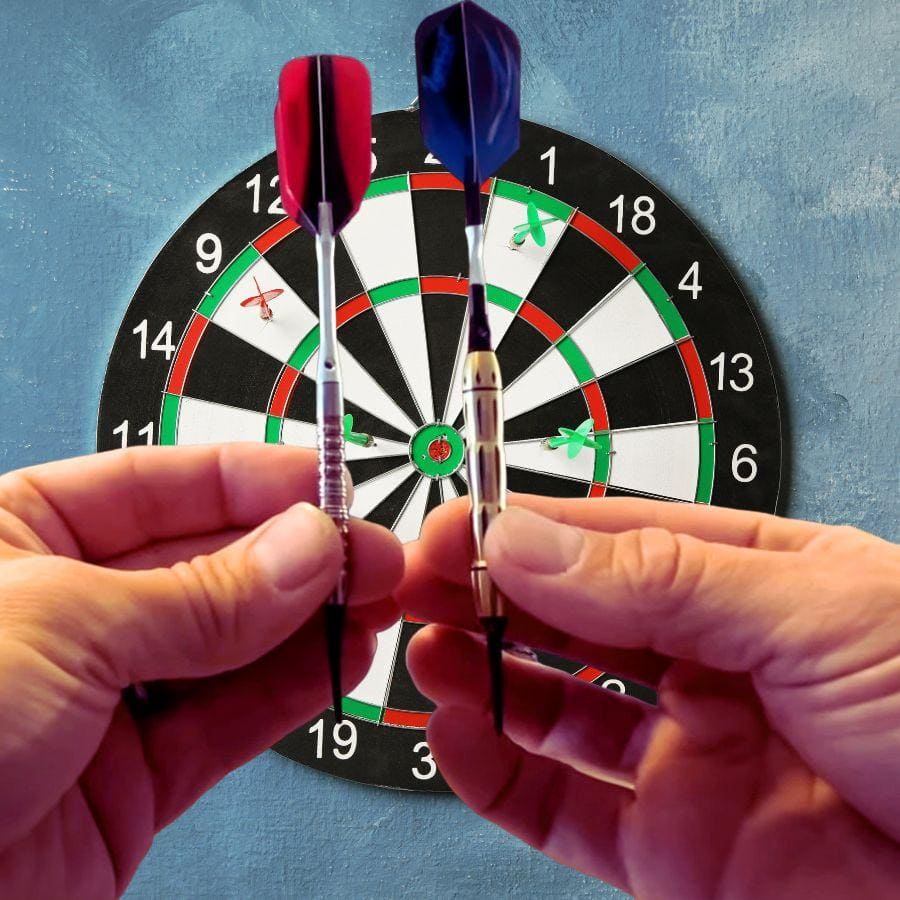
Popular Brands
Arachnid stands out as one of the oldest and most renowned electronic dartboard brands, earning its place as my personal favorite. This brand has consistently introduced innovative features, with the heckler mode being a particular favorite of mine.
However, alternative brands like Viper, Granboard, Fat Cat Mercury, Win Max, Bullshooter, and Franklin Sports also offer commendable options. Exploring newer brands is entirely viable, but it’s crucial to conduct a thorough product evaluation and delve into detailed reviews.
Personally, I extensively test intriguing products from lesser-known brands. This exploration led me to discover Granboard, a unique dartboard brand featuring smartphone connectivity and online multiplayer—a smart innovation I had yet to encounter elsewhere.
Easy Cleaning And Maintenance
For those with hectic schedules, opting for a wall-mounted dart board that demands minimal time and effort for cleaning is essential. Premium electronic cabinet sets prove to be particularly low-maintenance, thanks to the protective cabinet doors that effectively ward off dust.
Even if you’re working within a budget, there are affordable dartboard and cabinet combinations available for around $100, ensuring that you can enjoy a clean and well-maintained setup without breaking the bank.
Price Range
The price tag is certainly a significant factor to weigh in your decision-making process. Electronic dart machines span a wide price spectrum, ranging from under $50 to over $1500. While premium models like the Arachnid Cricket Pro 900 come with a higher price point, they offer a plethora of features that may justify the expense when compared to more budget-friendly alternatives.
However, if you’re opting for a more budget-conscious approach, models like the Fat Cat Mercury provide a decent compromise, though some features may be sacrificed.
Drawing from my experience with both economical and high-end soft-tip dartboards, I can confidently say that a satisfying gaming experience doesn’t necessarily require a $500 investment. Choose a board that aligns with your budget constraints, ensuring you extract the best possible value for your money.
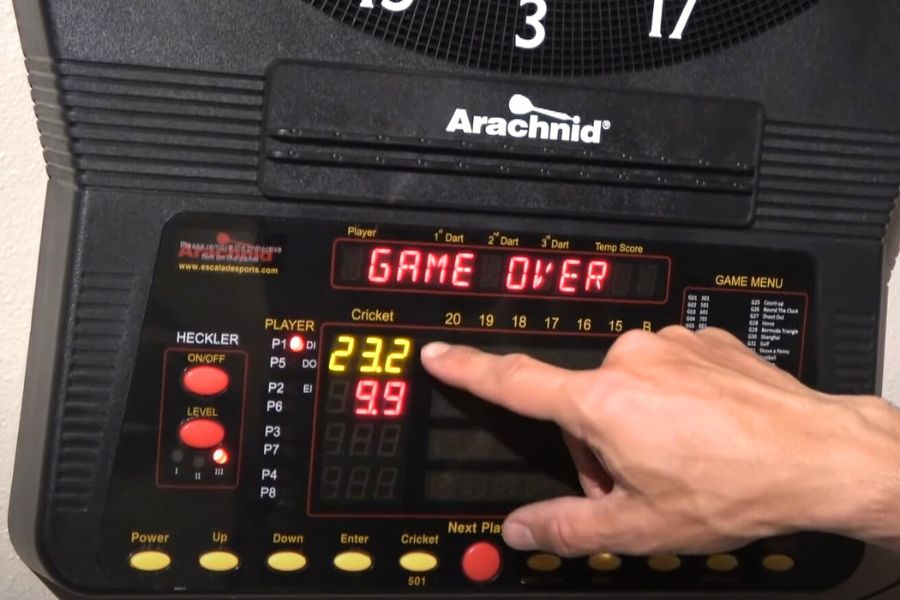
Frequently Asked Questions
An ELECTRONIC DART BOARD (also known as a soft-tip dartboard) bears a striking resemblance to traditional boards, but with a high-tech digital scoring system, in-built games, and light & sound effects. There’s another notable feature– the surface is typically crafted from robust plastic or resin instead of traditional wood, cork, or sisal fiber materials.
Now, you might wonder, how do the darts actually stay in place? My first encounter with an electronic dartboard revealed an intriguing secret – these boards feature hundreds of tiny pores on their plastic surface. When a dart makes contact, its tip nestles snugly into one of these minuscule holes, securing it firmly.
However, digital dartboards are INCOMPATIBLE with traditional steel-tipped darts. Instead, they require specialized soft tip darts with tips made of plastic and rubber, which is why they’re often referred to as soft-tipped boards.
Here’s what I love the most about these sophisticated dart boards – the scores are recorded electronically each time a dart enters one of those holes. An electronic display shows the total scores, based on the respective scoring mechanism, depending on the type of dart game you’re playing.
It’s a fusion of tradition and technology that elevates the darting experience to new heights.
Drawing from my extensive experience testing various home electronic dart boards, I feel that these are much better than the traditional boards. The inherent safety in playing with these alternatives is evident, and the infusion of innovative features significantly enhances the overall enjoyment of the game.
The Arachnid Cricket Pro 900 stands out as the premier choice among electronic dart machines, excelling in overall quality, performance, design, and value for money. If you’re seeking a high-tech dartboard that offers a unique playing experience, the Granboard 3s or Franklin Sports are ideal options. Conversely, for those prioritizing cabinet designs, the Viper Neptune stands as the perfect choice, closely followed by the Fat Cat Mercury, Win Max, or Bullshooter.
While you can find digital dartboards at local toy or hobby stores, the best selection often resides in outlets specializing in dart supplies. Personally, I find online shopping for dart board cabinets and accessories more advantageous. Beyond the convenience, the online marketplace tends to offer more competitive prices, making it my preferred avenue for acquiring quality dart-related equipment.
While heavier darts often provide a more stable and satisfying throwing experience, when it comes to electronic dart boards, the ideal choice is soft-tip darts weighing no more than 16-20 grams. Heavier darts, typically equipped with steel tips, can pose a significant risk of damage to your device. Prioritizing softer-tipped options ensures a safer and more conducive gaming environment for your board.
Embracing soft-tip darts is highly recommended when engaging with an electronic dart board. Even if the board is specifically engineered to accommodate traditional darts, opting for soft-tip darts is key to extending its lifespan. This strategic choice not only ensures compatibility but also contributes to the longevity and durability of your toy.
Since making the switch to soft-tip dartboards, one notable benefit is the peace of mind regarding potential wall damage from off-target throws. Soft-tip darts, lacking the sharpness and hardness of steel counterparts, pose minimal risk to your surroundings- walls, furniture, etc. While the dart tips may be susceptible to breakage or damage, ensuring a stock of spare tips is a prudent practice to maintain an uninterrupted and enjoyable gaming experience.
In my exploration of electronic dart boards, the Viper Showdown emerged as one of the most budget-friendly choices, sporting a price tag of approximately $50. However, venturing into the realm of high-end models unveils a more extravagant price range, with some options reaching beyond $1000. The diverse pricing spectrum caters to a range of preferences, accommodating both economical choices and those seeking premium features.
In electronic darts gaming, the 01 games (301, 501, 701, 901, 1101, 1501, etc.) stand out as among the most popular games. Those are hit due to their simple and entertaining nature, appealing to both casual and serious players. CRICKET, featuring variations like Standard, Hidden, and Cut Throat, has gathered a good following, adding diversity to the playtime. These games, known for their accessibility and excitement, have become favorites across different skill levels.
Electronic dartboards are gaining popularity not only among professionals but also in various competitions and events. Seasoned players often lean towards top-notch electronic dart board sets that come with a cabinet for storing their dart supplies, with models like Arachnid Titanium 5400 and Venus Neptune being popular choices.
The primary motivation behind my decision to switch to an electronic dart board was the safety it provides for my nephews compared to traditional machines. They stand out as the safest option for kids and teens (like my sister), featuring darts with soft rubber or plastic tips, a notable departure from the sharp steel tips present in conventional darts.
Electronic dartboards blend high-density materials with advanced electronics for a thrilling experience. Let’s take a closer look at its various components:
Dartboard Surface: The primary playing field of an electronic dart board is typically crafted from high-density plastic or nylon. This surface is strategically perforated with small holes designed to securely cradle the soft-tip darts upon impact.
Segments: The board is divided into distinct segments, each assigned its own point value. These segments are often fashioned from thin yet durable materials such as rubber or synthetic fibers. Color-coded and numbered, they create diverse scoring areas that add depth to the game.
Electronics: Behind the surface, an array of sensors and electronics spring into action. These sensors detect precisely where a dart lands and swiftly calculate the corresponding score. Additionally, they control the LED display, which showcases scores, game options, and other vital information.
LED Display: Most electronic dartboards come equipped with an LED display. It serves as the scoreboard, presenting the current player’s score and an array of game settings and options. You’ll typically find it positioned above or around the surface.
Buttons and Controls: Those boards offer convenience through buttons and controls. These features allow you to select game modes, tweak settings, and maintain an accurate score tally. Look for these controls on the sides or bottom of the dart board.
Power Source: To power the electronics and LED display, digital boards rely on a power source. This source often takes the form of batteries or an AC adapter, ensuring uninterrupted gameplay.
Cabinet: Many electric dart boards are bundled with a cabinet or housing that envelops the board, safeguarding it when not in use. These cabinets may also incorporate additional storage space for darts and various accessories.
Picture a circular target, typically 15.5 inches in diameter, adorned with a multitude of miniature openings, each with a crucial task: securely capturing soft-tip darts. Concealed within these pores, you’ll find tiny sensors, diligently recording each dart’s successful entry.
Beneath this seemingly ordinary surface, lies the electronic heartbeat of the dart board – a complex network of connections poised to bring your game to life. Those concealed sensors work tirelessly to detect every dart’s impact, instantly translating it into a digital score displayed on the LCD.
Electronic dartboards truly shine for their technology: effortless and immediate scoring, sparing you the hassle of manual calculations. To put it simply, every dart that finds its mark triggers a sensor, transmitting an electric signal to register and display your score.
However, there’s an essential rule to remember: steel-tipped darts and electronic dartboards don’t work together. Those sharp steel tips can pose a threat to the delicate sensors inside.
BUT HERE’S THE TWIST: advanced electronic boards are designed to take on the challenge, seamlessly blending tradition and technology for those who relish the best of both darting worlds.
In the realm of electronic darts, the distance from the shooting line to the target is set at 8 feet (244 cm). Interestingly, this measurement is only slightly longer than that of steel-tipped darts on traditional boards. For the classic dart board, the official shooting line stands at 7 feet and 9.25 inches, equivalent to 237 cm.
Additionally, when it comes to the height of the bullseye from the floor, both electronic and traditional dartboards adhere to the same standard, with the official measurement fixed at 5 feet and 8 inches, which translates to 173 cm. This uniformity ensures a consistent playing experience across both darting worlds.
So, Which Electronic Dart Machine Will Be Perfect For Your Home?
In the current market of electronic dart boards, there’s a diverse array of choices suitable for both seasoned players and newcomers. Your selection depends on factors like budget, personal preferences, and the intended use of the device.
To help you out, here I have made a comparison table for the electronic dart board sets I have listed in this article.
| Model | Target Area | No. of Games | Scoring Options | Rating |
|---|---|---|---|---|
| Arachnid Cricket Pro 900 Dart Board | 15.5″ | 48 | 354 | 4.7/5 |
| Granboard 3s Digital LED Dartboard | 15.5″ | 25+ | 100+ | 4.7/5 |
| Viper Neptune Electronic Dart Machine | 15.5″ | 57 | 300 | 4.6/5 |
| Fat Cat Mercury Electric Dart Board Set | 13.5″ | 28 | 150 | 4.5/5 |
| Win Max Soft-Tip Dart Board Set | 13.5″ | 27 | 259 | 4.4/5 |
| Bullshooter Electronic Dartboard | 13.5″ | 34 | 183 | 4.4/5 |
| Franklin Sports Electronic Dart Board | 13″ | 48 | 315 | 4.3/5 |
To sum up, Arachnid Cricket Pro 900 is the OVERALL BEST electronic dart board in terms of quality, design, appearance, performance, and value for money. However, for those seeking a tech-savvy experience right at your home, the Granboard stands out with its exclusive online multiplayer function, connecting players globally.
For those inclined towards a cabinet-covered dart board, options like Viper Neptune, Fat Cat Mercury, and Bullshooter stand as excellent choices. Each product offers unique features catering to different preferences, ensuring there’s a perfect fit for every darts enthusiast.
This guide aims to provide practical insights from my first-hand experience, helping you make an informed decision based on your budget and specific preferences.
Cheers to finding the right dartboard for your needs!
Continue Reading More About Digital Dart Boards:


Nice list of great quality electronic dart boards- this is exactly what I was looking for. I have just ordered an Arachnid Cricket Pro 900 for my game room. Thanks a lot for your recommendations.
You are most welcome! I’m glad to help you out.
Hello Tavish, I appreciate your recommendations for electronic dart boards. I have a specific question. I’ve been playing on bristle boards for a long time and now I want to introduce my 10-year-old son to darts. Since steel tips are not suitable for children, I’m looking for a soft tip board. However, I also want to join my son in the game and get the classic vibe. Do you have any suggestions?
I’m glad you’re considering introducing your son to darts. For your situation, I recommend the Arachnid Cricket Pro 900 and the Viper Neptune electronic dartboards. Both are excellent choices for soft tip boards, allowing you to enjoy the game with your son without any safety concerns.